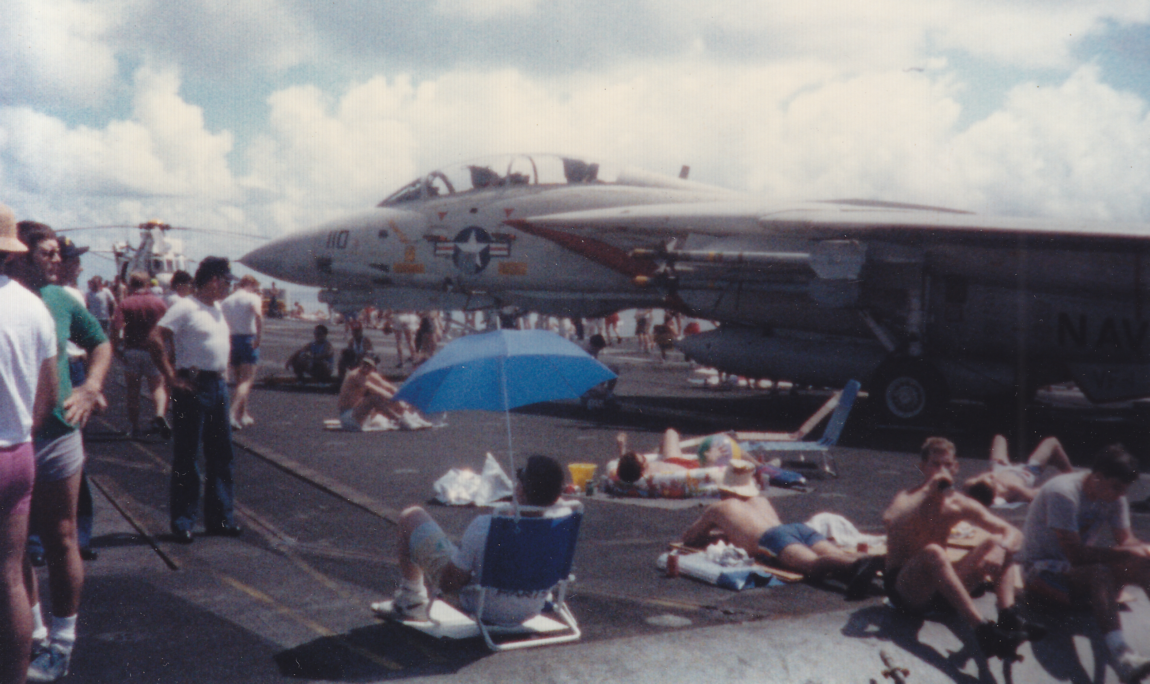A Cold-War Snapshot of Life Aboard an Aircraft Carrier
Synchronized Chaos

It has been called “the flight deck ballet” and”synchronized chaos.” Even in peacetime, it is said to be among the most dangerous work environments on earth. And yet we loved it! During operational down times, an Aircraft Carrier flight deck with her full complement of eight Airwing squadrons aboard and 50-65 planes abovedecks is a scene of constant and colorful motion. With space at a premium, aircraft are continually re-positioned to and from the landing area and the forward and waist catapults in anticipation of the next planned operational sequence. “Keep your head on a swivel,” we were constantly warned. It is the actual launch and recovery operations that were the most impressive, though. Picture jet engines from numerous aircraft blowing their exhaust in multiple directions, noise and steam obscuring hearing and sight-lines, wings folding and unfolding, tailhooks, launchbars, arresting gear, catapults, and jet blast deflectors in constant motion, and hundreds of crew scurrying this way and that to carry out their assigned responsibilities. Picture this at night, and the scene seems even more unreal. Flight Operations aboard a forward deployed Aircraft Carrier are invariably high-tempo and high-stress. The contemporary Navy recruiting ads promised, “It’s not just a job, it’s an adventure!” There and then we groused among ourselves, “When does the adventure begin?” Looking back now through the nostalgic fog, it was indeed the adventure of a lifetime.
No Phones, No Females, No Alcohol

We were on station in the North Arabian Sea, and as was the usual routine when underway, we worked 12 hours on/12 hours off, seven days a week. An E-2C Hawkeye early-warning reconnaissance aircraft was nearly always aloft along with the Combat Air Patrol – two F-14 Tomcats. Threats to the Battlegroup came in many forms, and this constant state of readiness takes a toll on even the best trained units. An anticipated port call at Mombasa, Kenya was cancelled at the last minute by an incident in the Persian Gulf and, as a result, we had been “haze gray and underway” for an extended time.
Beyond mail call (letters from the ship would usually take about 9-10 days to reach the U.S., thus an answering letter would not be received for almost 3 weeks at best after the initial correspondence), communication with the outside world was almost nil in this pre- e-mail era. Female conversation and companionship was sadly lacking too. Finally, despite a colorful history of rum rations and grog (note the nautical origins for the terms groggy, three sheets to the wind, and down the hatch, for example), U.S. Navy ships were and are alcohol-free with very limited exceptions. A recent Fleet-wide decision, however, had dictated that after 45 consecutive days at sea, each ship’s crewman would be allowed two beers. Everyone on the ship seemed to realize this, and as we approached 60 days with no beer (or port of call) in sight, the Captain announced that he would make a party of it just as soon as outside events allowed.
Beer Day/”May” Day

When the eagerly anticipated day arrived, the flight deck was cleared as much as was practical with 90 aircraft and helicopters aboard. Hamburgers and hot dogs were grilled in the open air, and somehow – despite extremely limited room to store personal items aboard ship – aluminum lawn chairs and chaise lounges as well as inflatable and plastic kiddie pools appeared among the beach towels surrounding the tied-down airplanes. Most of the crew took the opportunity to sunbathe, read, toss Frisbees or softballs, or simply relax and chat with friends. I think we were each given two beer chits, and the non-drinkers sold, bartered, or donated their chits to their fellow shipmates with the result that some had four or even more beers before the party ended.
As the afternoon progressed, we were treated to a quintessential Cold-War scene as a Soviet Union Ilyushin IL-38 “May” maritime patrol aircraft approached the ship from the direction of the port bow. Recognizing that our E-2 and F-14’s were not providing air cover as usual, the May took advantage of the opportunity to take surveillance photos of a U.S. Aircraft Carrier at sea. As our ship was one of the soon-to-be-extinct diesel-powered flattops, my guess is that precautions were taken to hide any truly sensitive weapons and electronics systems from view and that the flyover was not entirely unexpected. I could be entirely wrong, of course, and heads may have rolled following the incident.

In any event, we heard the aircraft before we could actually see it, and as it circled the ship, we clearly saw the pilot and co-pilot peering down at us at our leisure. Many of the crew shook their fists at them, a few exposed their bare buttocks, and a majority extended their middle fingers in a less than cordial greeting to the aircrew. The visit could not have lasted more than ten minutes. Following the incident, we excitedly discussed the exhibition before eventually returning to our party.

As it turned out, we ended up spending 105 consecutive days at sea – said to be a record for aircraft carriers at the time – before arriving at our next port of call. That is a remarkable stretch of time in retrospect. More than half of our six month Western Pacific cruise was spent consecutively at sea, conducting high-tempo flight operations day and night – with the exception of one memorable day. I think the Captain still owes us that second Beer Day.





No Comments